Best patio plants – 11 stunning options for adding flowers, foliage and scent to your paved space
Whether added to containers or planted nearby, these patio plants are guaranteed to brighten up any outdoor space

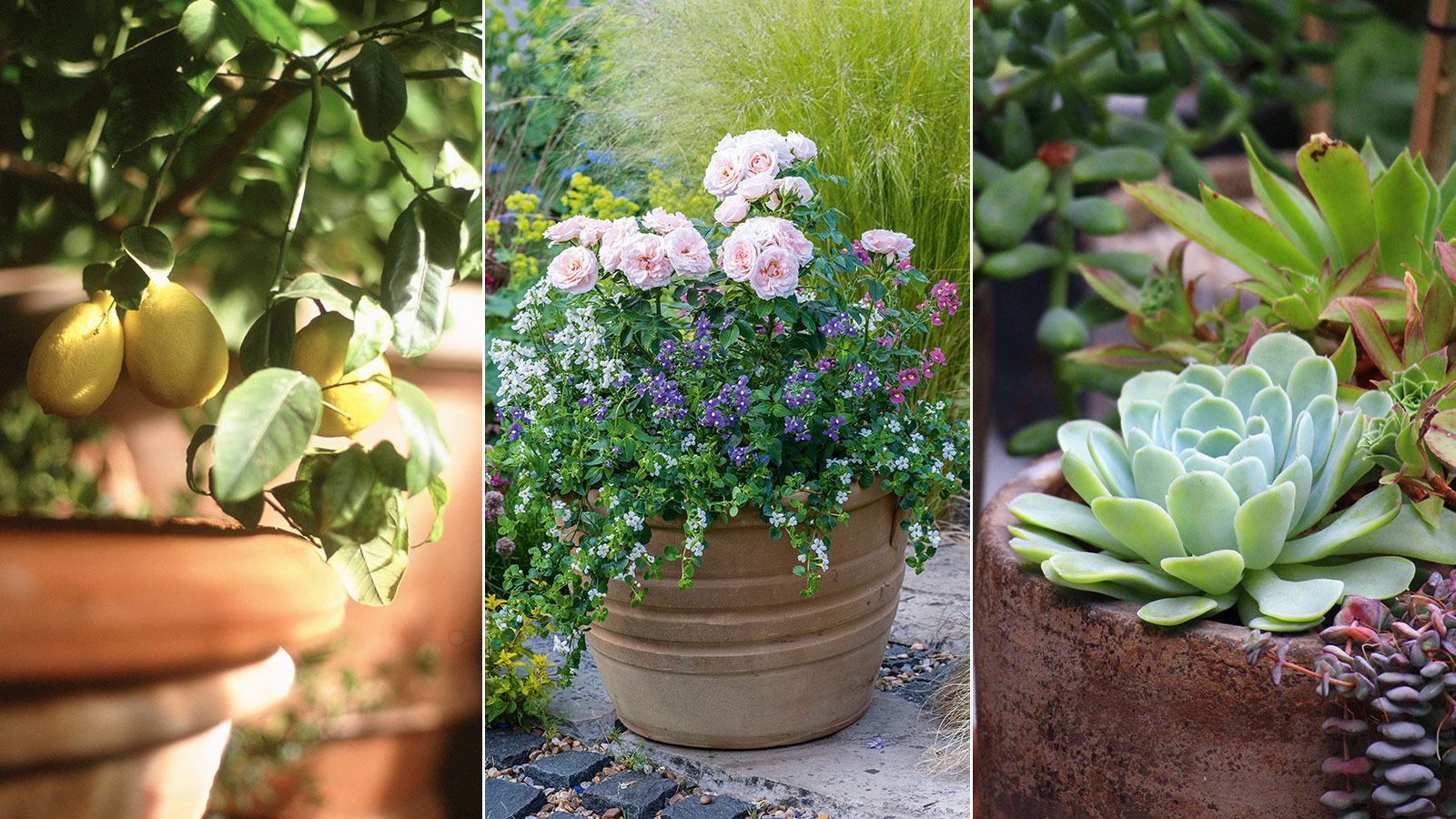
Your patio is like an extra room outside, where you can relax at the end of the day and party at weekends. Of course it needs furnishing, but it also needs decorating – and this is where patio plants come in.
Colorful patio plants in attractive containers, or set out in planting areas nearby, can be chosen for the long term, to develop into impressive specimens over the years. They can also be chosen for the short term to provide color and interest to your patio in their peak season and then be changed for other varieties to continue the display.
Some patio planting ideas provide color, some bring us fragrance, and many of today’s deck and patio flowers have been developed for their long flowering season as well as their color and scent. Foliage is often an important feature and, in some cases, can be as bright or as dramatic as flowers. It can also, in some cases, last through the winter when your deck or patio may be viewed more from the house.
11 patio plants for vibrant outdoor spaces
Shape and structure are important features, so although plants for pots are an obvious choice for patio planting, do not dismiss shrubs or small trees on the basis that they are simply too large. Choose carefully and they can bring a very satisfying presence, even if you only have a small patio.
1. Begonias

Begonias are available in a wide choice of colors
- Good for: Planters, hanging baskets, border edging
- Planting suggestion: Mix with annuals with blue flowers such as ‘Laguna’ lobelias
- Deer resistant: Partly
- Hardiness: USDA 10
Begonias are splendid plants for container gardening on sunny or shaded decks and patios, and they come in ever increasing range of colors and styles. Most are modest in size, but often spectacularly colorful, although it is important to remember that begonias are frost tender, hardy to USDA Zone 10, but prolific in bloom. They come in three main groups.
Tuberous begonias have neat, toothed, bronzed or dark green foliage and flamboyant single or double flowers in just about every color except blue. The flowers are noticeably larger than those of other types. Look for the Non Stop Series, with double flowers on neat plants; the Summerwings Series of trailing varieties, and the larger flowered Illumination Series are good plants for hanging baskets.
Wax begonias have small, glossy leaves in green or rich bronze. The small single, golden-eyed flowers come in reds, pinks and white and flower for many summer months until hit by frost. Look for the Surefire Series, in four colors with more on the way; the larger ‘Dragon’s Wing’ and many more.
Design expertise in your inbox – from inspiring decorating ideas and beautiful celebrity homes to practical gardening advice and shopping round-ups.
Foliage begonias have larger, toothed leaves patterned in green, bronze and silver. Look for ‘Gryphon’.
Top growing tips: Grow begonias in full sun in northern summers, then the warmer the situation the more shade they appreciate. They also enjoy consistent moisture, regular fertilizing, and protection from frost.
2. Caladium (Angel Wings)
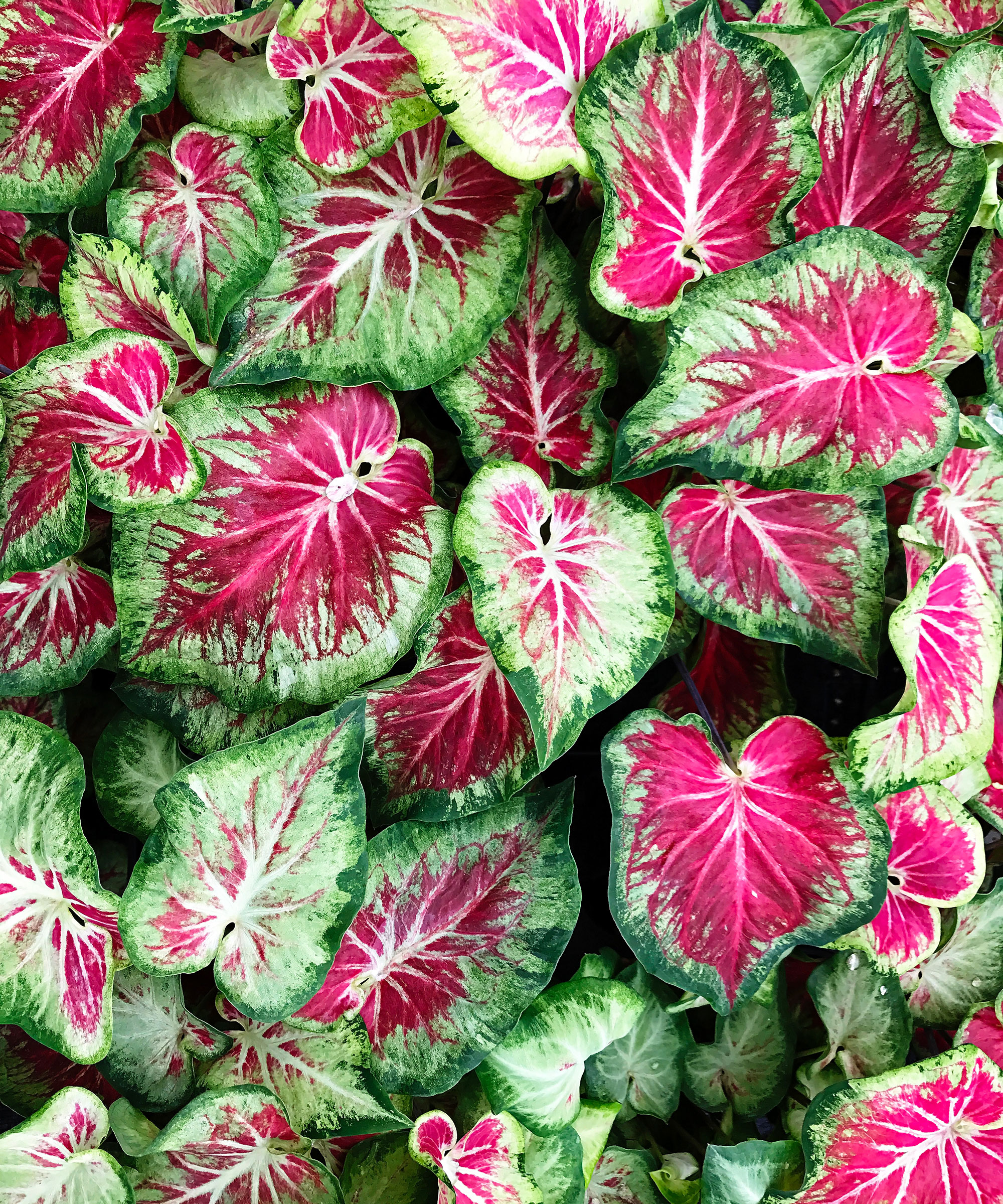
Caladiums are known for their stunning foliage
- Good for: Brightening shade, dazzling visitors
- Planting suggestions: Dramatic as a specimen in a planter, with ferns or with larger begonias
- Deer resistant: Partly
- Hardiness: USDA Z9
Stunning heat-loving foliage plants for areas with hot summers, caladiums are grown for their big, bold, heart-shaped leaves presented in an amazing combination of bright colors including red, orange, pink, white, silver and green, with the markings arranged in striking patterns.
Caladiums grow from tubers about 3in across. Look for the Heart-To-Heart Series in 20 different color patterns, and choose those that especially appeal. Caladiums provide foliage colors seen in no other plants.
Top tips Start the bulbs in fresh, moist potting soil in a sun room or outside if the temperature is above 55˚F. New leaves will keep coming all summer, then as the temperature drops in fall the leaves will die away. Or buy and plant in full growth.
3. Citrus

Growing a citrus tree in a container on your patio makes it easy to move it indoors if you live in an area that experiences frosts in winter
- Good for: Their long flowering and fruiting season, and their super-scented flowers
- Planting suggestion: Valuable as a specimen, surrounded by seasonal flowers
- Deer resistant: Mostly
- Hardiness: USDA Z9
Popular sub-tropical evergreen fruit trees for milder climates, citrus are grown not only for their lemons, limes and other familiar fruits, but also for their fragrant white flowers. Lemons and limes are usually the easiest citrus to grow, but get local advice for guidance on which citrus grow well in your area to avoid making a patio planting mistake.
Citrus trees make impressive long-lived shrubs or trees for small gardens and, in many areas, are best grown as individual specimens in planters filled with lime-free potting soil. Citrus will usually crop fairly well without pruning, but regular irrigation is helpful. Fertilizing with a specially formulated citrus feed will improve the crop.
Look for lemons, and perhaps limes, in your local walk-in nursery, and other types by mail order.
Top growing tips: You can grow citrus in outdoor planters on the patio for summer, but be aware that they do need a mild garden or to be moved into a frost-free place, such as a sun room, for winter.
4. Gerbera

Gerberas are good options for a cutting garden
- Good for: Deck and patio pots, sizzling summer borders, cutting garden flowers
- Planting suggestion: Grow with caladiums, larger begonias, coleus, as specimens
- Deer resistant: Partly
- Hardiness: USDA Z8/9
These stunning South African daisies feature upward-facing flowers in vivid shades carried individually for many months on upright stems that spring from a rosette of lobed or boldly toothed foliage.
Quickly making fine specimens in individual pots, choose from the many shapes, colors and patterns to create features or to harmonize with your other plants.
Borderline hardy in USDA Zone 8, recent developments have brought us a wider variety of more intense flower colors and color combinations, a longer flowering season, more varieties with double or crested flowers, and better vase life when cut along with improved hardiness.
Increased winter hardiness and heat tolerance are also being developed along with continuous blooming. Look for the Garvinea Series (more winter hardy than others), Patio Series (dazzling colors), Revolution Series (early to flower).
Top growing tips: Fertilize regularly, deadhead regularly, use flower food with cut stems.
5. Hostas
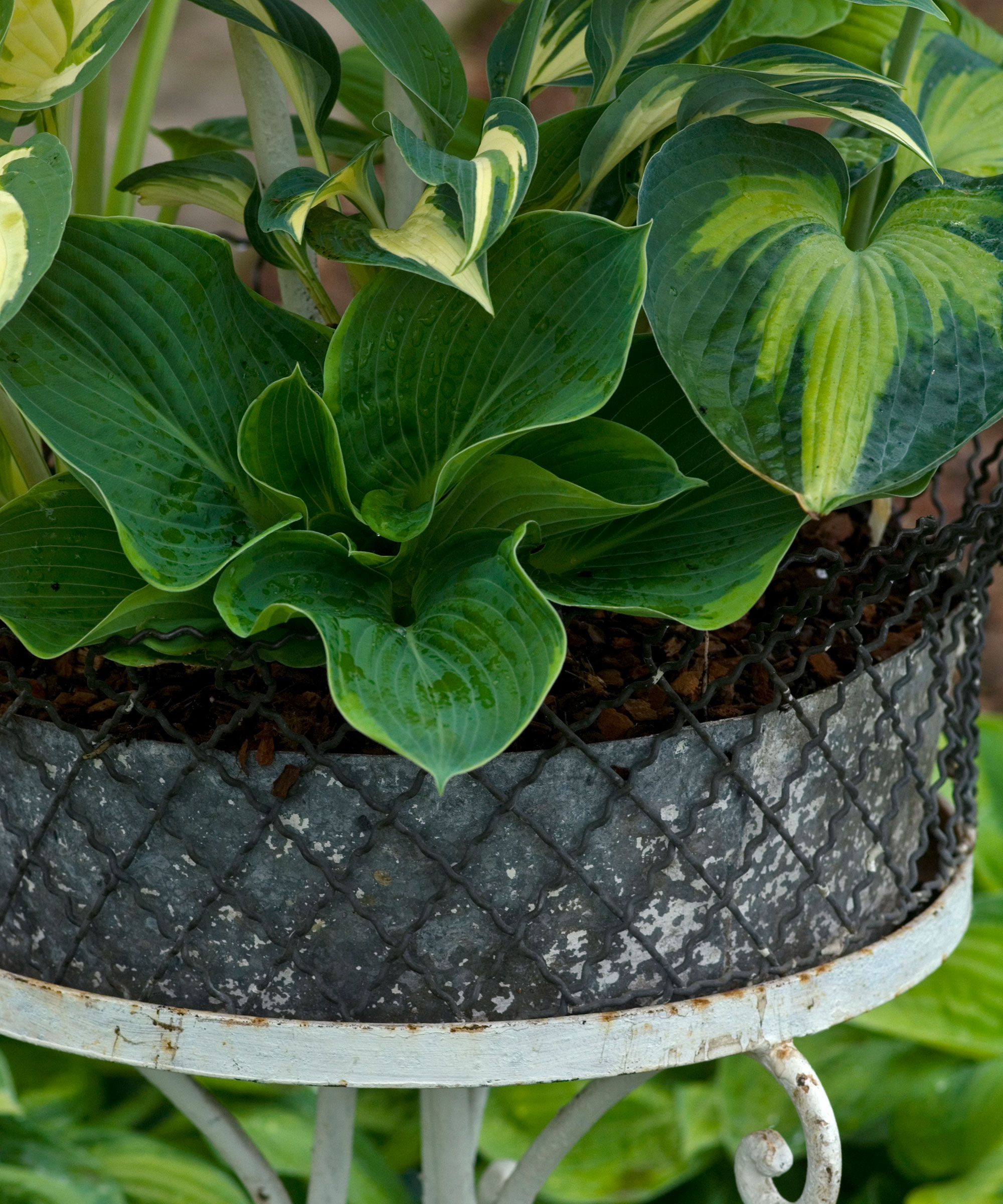
Hostas will grow well in a shady spot on your patio
- Good for: Impressive specimens for planters on the shady side of the deck or patio, or as ground cover in nearby borders
- Planting suggestion: Partner with the slender foliage of grasses and sedges, especially varieties with colored leaves
- Deer resistant: No
- Hardiness: USDA Z4
Hostas are impressive hardy perennial, foliage plants, with leaves that vary from broadly heart-shaped to slender and pointed and which die back for the winter. The foliage springs from a tight, steadily spreading crown and comes in greens, blues, yellow and gold shades and a vast variety of variegations.
Reaching anything from a few inches to a few feet tall and wide, some varieties also feature fragrant white or lavender flowers. Hostas are shade plants in the south, but enjoy more sun in the north as long as the roots remain damp. The variations in color and pattern have led to a huge number being named.
Look for these widely grown varieties: ‘Blue Mouse Ears’ (small, with neatly cupped blue leaves), ‘Frances Williams’ (large, broad, bluish leaves with yellow-green edges), ‘Patriot’ (medium-sized, white-edged green leaves).
Top growing tips: After planting hostas, never allow them to dry out. Installing a drip watering system will make regular irrigation easy, especially if you are growing them as a container plant in the shade.
6. Petunias

Trailing varieties of petunia can be used for pretty hanging baskets on a summer patio
- Good for: Sparkling color all summer, and available in an exceptional range of colors
- Planting suggestion: Grow petunias as specimens, planting three or five plants in individual planters or baskets, or interplant them with other foliage and flowering plants in harmonious or contrasting combinations
- Deer resistant: Partly
- Hardiness: USDA Z10
The most popular of all annual flowers for patios, the trumpet-shaped flowers come in literally every color of the rainbow (plus black), and in an increasing range of eye-catching color combinations. Some are even scented.
Varying in growth from neat and bushy to vigorous and trailing, these summer sun lovers flower prolifically with little care and attention except regular watering and fertilizing.
Look for Crazytunia Series (unusual color combinations), Tumbelina Series (fragrant double flowers; semi-trailing), and the Wave Series (single flowers, trailing).
Top growing tips: Irrigate and fertilize regularly. Deadheading petunias will also encourage more blooms.
7. Pieris
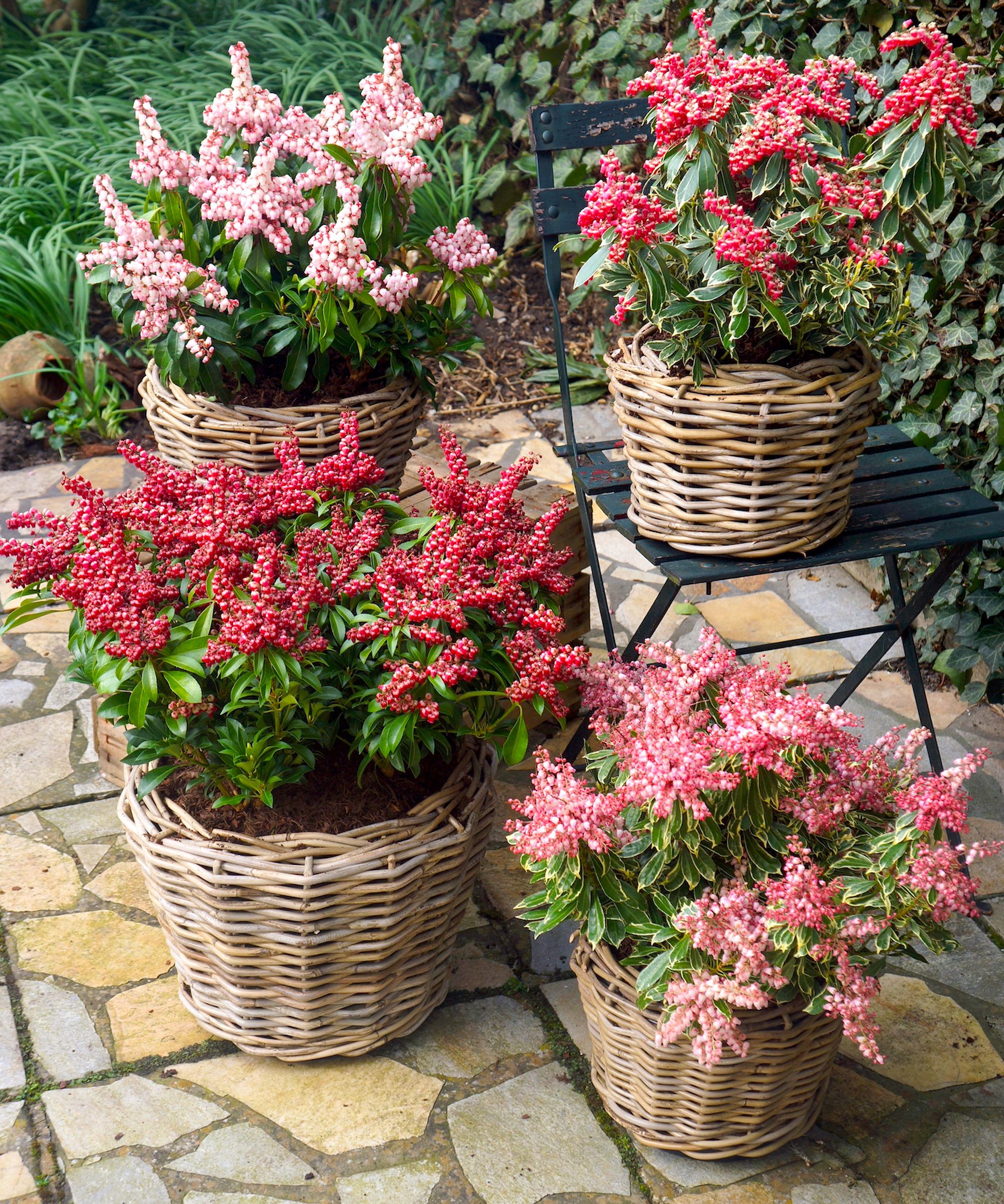
As pieris need acid soil, it can be easier to grow them in containers on a patio
- Good for: Deer resistance, our coldest zones, colorful spring displays
- Planting suggestions: Plant trailing, variegated ivies around the edge of the container
- Deer resistant: Yes
- Hardiness: USDA Z2
These easy-to-grow evergreen shrubs, related to the wild American andromeda bush, feature glossy oval foliage, bright red new spring growth, and clusters of small, white, bell-like flowers like lily-of-the-valley. Some of the finest also bring us leaves edged in white. All are deer resistant and feature impressive winter hardiness.
Pieris needs acid (lime-free) soil, as do azaleas and rhododendrons, so are unsuitable for many gardens. But both pieris, and azaleas, can be grown in containers of appropriate potting soil.
Look for established favorites such as ‘Forest Flame’ (white flowers) and ‘Valley Valentine (pink flowers), plus varieties with variegated foliage including ‘Carnaval’ and ‘Flaming Silver’.
Top growing tips: Grow a pieris in a planter filled with azalea soil, such as this Coast of Maine organic compost potting soil for acid loving plants at Amazon.
8. Roses
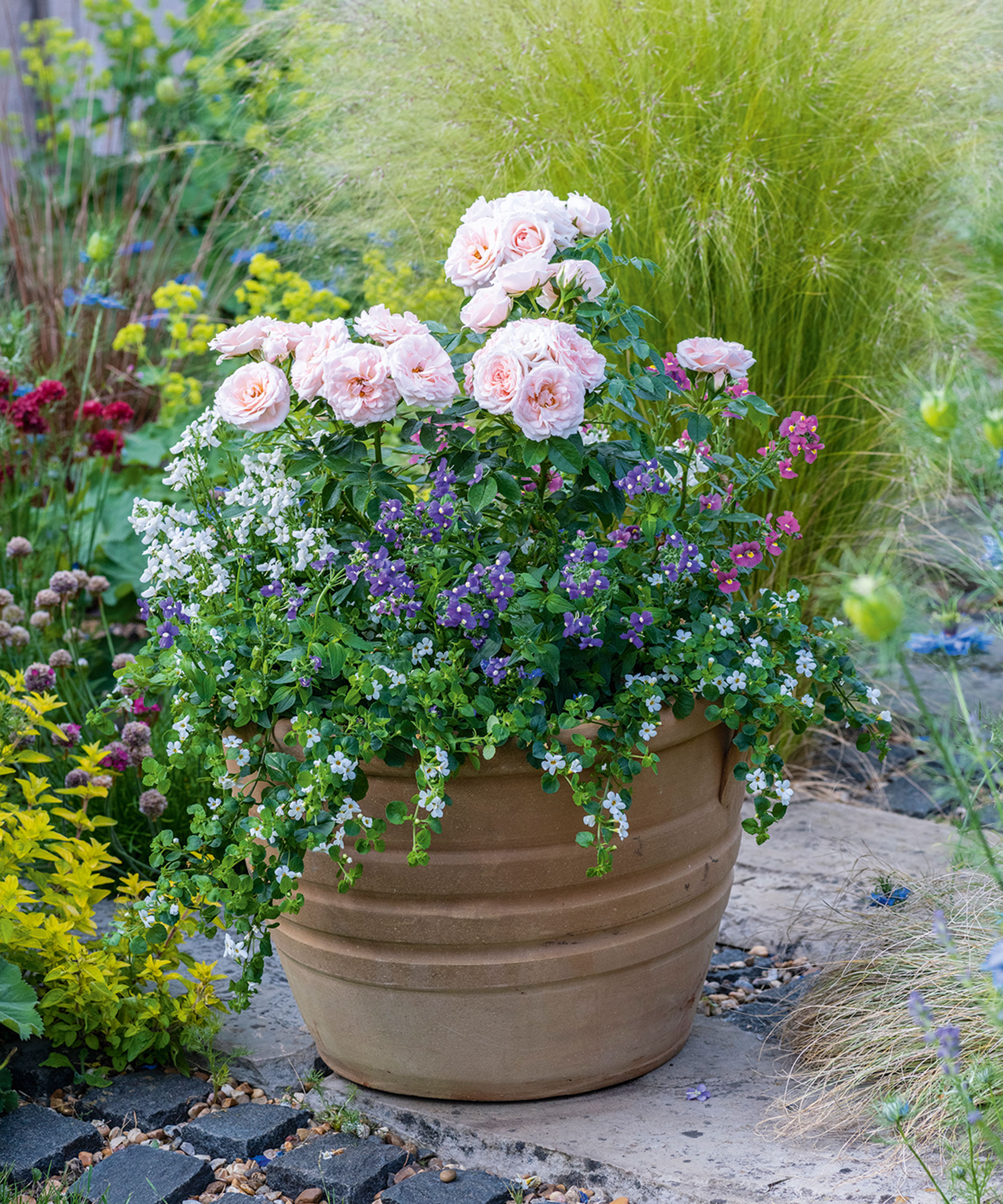
The patio rose 'Lovely Bride' takes center stage in this beautiful patio planter
- Good for: Fragrance, color, general good health, few thorns
- Planting suggestion: As a specimen, with pastel petunias, in large planters and sunny mixed borders. Some are good as medium height hedges to shape the garden room
- Deer resistant: Partly
- Hardiness: USDA Z4
Fragrant roses growing in a planter on the patio make quite a feature, and they are the perfect addition to a cottage garden patio. Months of summer color are combined with those classic fragrances to create endless appeal and, especially in cooler, more northern zones, roses are ideal in patio planters.
We need varieties that mature at a modest size, and which flower all through the summer, and some of the legendary David Austin English Roses, tested and specially selected for American gardens, make a good choice. The right combination of classic flowers can also help to make a patio look expensive.
Of course roses are thorny, so you may think that they’re unsuitable for decks and patios where people, including kids, are often moving around. But some English Roses are less thorny than others so look for the almost thorn-free: Brother Cadfael (Ausglobe) (large flowered, double pink), Kew Gardens (Ausfence) (clouds of small, ingle white flowers), The Shepherdess (Austwist) (double apricot flowers), and Lichfield Angel (Ausrelate) (peachy buds, cream flowers).
Also look out for the neat, completely thorn-free, pink and white ‘Cutie Pie’.
Top growing tips: Learn how to prune roses for better blooms each year – every spring as growth is beginning is typically the ideal time to do it.
9. Succulents
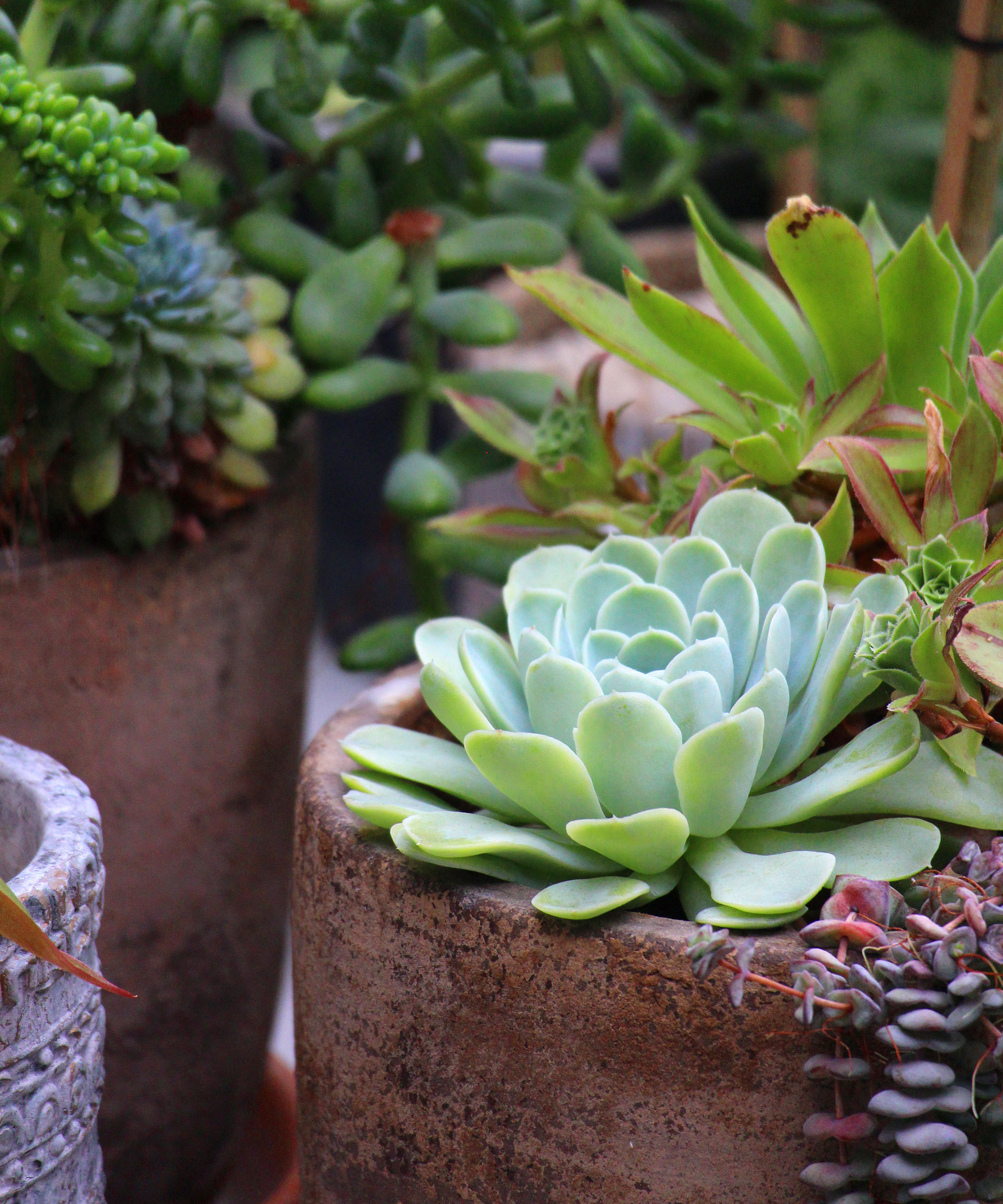
Potted succulents make an attractive centerpiece to a patio, or when displayed on an outdoor table
- Good for: Drought gardens, deck specimens
- Planting suggestions: Set against gravel, which will show off their shape
- Deer resistant: Mostly
- Hardiness: USDA Z9
Succulents are plants that have adapted to hot, dry conditions by developing swollen leaves that store moisture. In the south, especially the dry southwest and into Mexico, they are widespread and include cacti, agaves (from which tequila is made) as well as aloes. Many have a bold, structural look.
Succulents make fascinating specimen plants for deck planters or gravel gardens round the patio in our warmest zones. They enjoy plenty of sun, well-drained potting soil and will die if overwatered. Many are spiny – the spines are an adaptation to prevent animals raiding these moisture-filled plants, so it may be wise to look for spine-free varieties if young kids are likely to be around.
Look out for cacti, agave, aloe (especially Aloe vera, valuable for its medicinal qualities), and mangaves with their increasing range of patterned rosettes of juicy foliage.
Top growing tips: When caring for succulents outdoors, all insist on full sun, a well-drained garden site or well-drained potting soil, and frost-free winters.
10. Viola
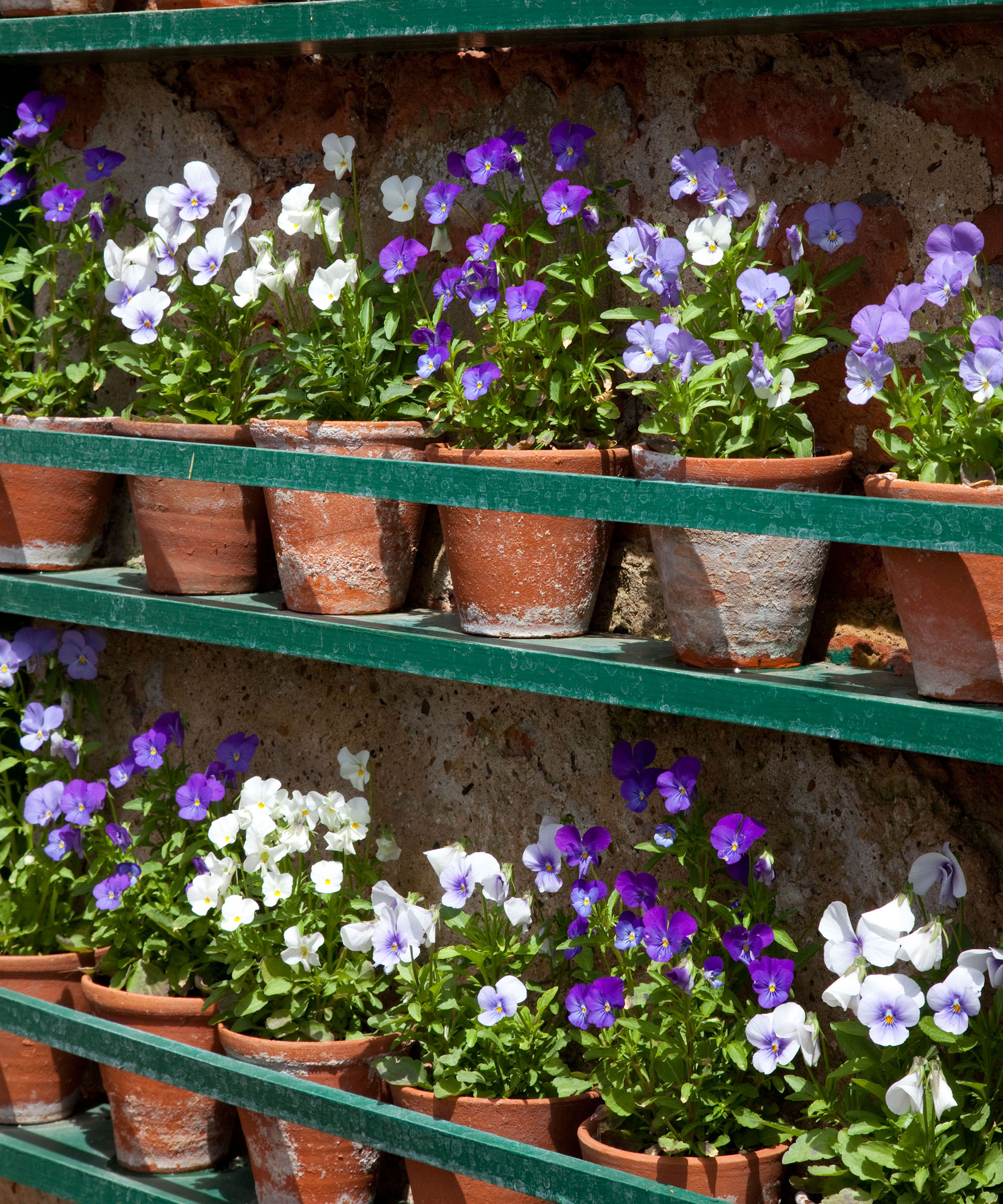
Planted in pots en masse, violas make an attractive patio display
- Good for: Planting alongside the deck, in small containers, in mixed spring containers with spring bulbs, in spring window boxes and even in baskets
- Planting suggestion: Grow with other violas, dwarf wallflowers, colored-leaved sedges, dwarf spring bulbs
- Deer resistant: Partly
- Hardiness: USDA Z4
These pretty little whiskered flowers are among the most valuable for cool seasons and cooler parts of the country. Violas are offered in an exceptional array of colors and color combinations, but these are not long term plants. Grow them for flowering in late winter and spring, for fall and winter in mild areas and for summer in colder zones.
Available as individual plants in small pots, or in packs of six or more, their value, in terms of flowers per dollar, is exceptional.
Look for the Sorbet Series and Sorbet XP Series, together in almost 30 colors and color combinations.
Top growing tips: Feed plants in containers regularly, and look out for aphids.
11. Bamboo
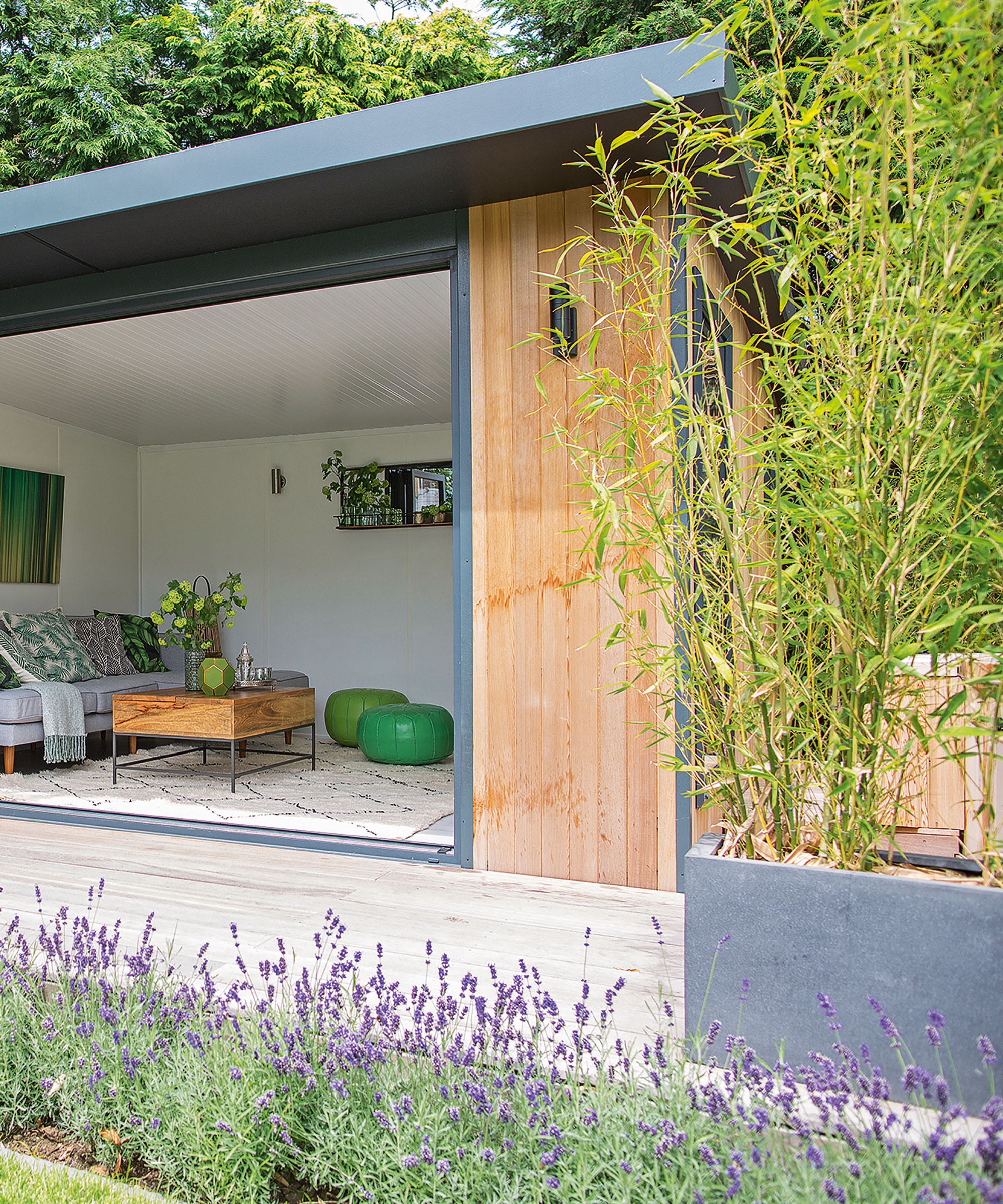
Bamboo are ideal for adding a tall screen to the edge of a patio
- Good for: Privacy screens, growing in containers
- Planting suggestion: Plant in a row of containers for a living patio screen
- Deer resistant: Mostly
- Hardiness: varies depending on variety
As a fast-growing plant, bamboo will quickly bring an air of maturity to a patio or deck. It’s this rapid growth rate that can be one of its downsides, however, so grow in a planter to restrict the vigorous roots of some varieties and stop bamboo from spreading.
For taller privacy screens, look for black bamboo (Phyllostachys nigra), whose canes become black as they mature, and golden bamboo (Pyllostachys aurea) with yellow canes. Both mature at about 12ft.
Top growing tips: By cutting back bamboo you can keep the height of your privacy screen in check, plus it will also encourage the plant to grow more foliage so you have a leafier, more lush patio hedge.
What are the best low-maintenance patio plants?
All patio plants need regular watering and fertilizer, but some need little else. Succulents need very little additional attention, except the occasional removal of flower heads and the removal of old leaves on rosette types.
Begonias, impatiens and petunias look after themselves happily through the summer and do not usually even require deadheading. Low-maintenance shrubs such as roses need pruning once a year, but pieris need nothing. Boxwood needs the occasional trim.
Caladiums and hostas simply need their fading foliage tidying away at the end of the season. Frost tender annuals including begonia, coleus, impatiens, pelargoniums and petunias need pulling out and removing to the compost heap at the end of the season.
The ultimate do-nothing plant is probably pieris.
What are good tall patio plants?
If patio privacy is a key factor for you, then bamboo grows to almost its full height in its first year, and reaches its mature height the year after. As they mature, their height remains much the same but the crown spreads.
Other tall plants to consider include sunflowers, many of which will reach 8ft, climbing roses (‘Zephirine Drouhin’ has no thorns), and citrus will develop into small trees. There are also varieties of clematis that will grow to 30ft.
How often do you need to feed and water patio plants?
Patio plants need watering and fertilizing most often in late spring and summer when temperatures are high, plants are growing strongly and rainfall is low. But plants vary so much in their size, their rate of growth and their need for moisture that it is not possible to give simple advice: watering plants once a week may be too much in some situations and not enough in others. However, if the potting soil feels dry two inches below the surface, then irrigation is needed.
The best way to deal with the watering is to set up a drip irrigation system. A slender, unobtrusive black pipe is set up around the patio with individual nozzles for individual plants – then you simply turn on the tap and all the plants are watered, all at once.
Feed every two or three weeks while the plants are growing well. Either choose a specific feed formulated for patio or container plants or use a tomato feed. Tomato fertilizer is good for many flowering plants, as well as tomatoes, peppers and cucumbers. Something like Tomato Tone from Amazon would be suitable.
Also, it is important to remember that surplus moisture must be free to drain away quickly. So all plants growing in planters should be raised off the ground using pot feet (also known as plant feet or pot toes), to allow surplus moisture to drain away. These rubber pot feet from Amazon would be suitable, or if you prefer a more decorative feature then these ceramic pot feet (also from Amazon) would fit the bill.
Once you've chosen your favorite patio plants, it's worth cleaning your flower pots before planting them to ensure you don't transfer any pests or diseases to your new plants.
What's more, remember that regular fertilizing during the growing season is important to ensure your patio plants continue to thrive and bloom for as long as possible.

Graham Rice is a garden writer who has won awards for his work online, and in books and magazines, on both sides of the Atlantic. He is a member of a number of Royal Horticultural Society committees and the recipient of the 2021 Garden Media Guild Lifetime Achievement Award. He gardened in Pennsylvania for 20 years, but has recently returned to his native England.